Geoherbalism Metabolomic Analysis of Atractylodes lancea (Thunb.) DC. by LC-Triple TOF-MS/MS and GC-MS
Abstract
1. Introduction
2. Results
2.1. Identification of Isolated Compounds
- Compound 1: 1H-NMR (500 MHz, CDCl3): 7.38 (1H, d, J = 1.6 Hz, H-4′), 6.79 (1H, d, J = 16.0 Hz, H-1), 6.42 (1H, dd, J = 3.4, 1.8 Hz, H-3′), 6.37 (1H, d, J = 3.3 Hz, H-2′), 6.36–6.28 (1H, m, H-8), 6.11(1H, d, J = 15.9 Hz, H-2), 5.64–5.56 (1H, m, H-7), 1.83 (3H, dd, J = 6.9, 1.8 Hz, H-9). 13C-NMR (500 MHz, CDCl3): 151.96 (C-1′), 143.71 (C-8), 143.58 (C-4′), 130.81 (C-1), 112.16 (C-2′), 111.15 (C-3′), 110.03 (C-7), 104.93 (C-2), 82.00 (C-6), 80.31 (C-3), 77.26 (C-4), 72.64 (C-5), 19.04 (C-9).
- Compound 2: 1H-NMR (500 MHz, CDCl3): 5.53 (dd, J = 8.1, 3.1 Hz, 1H), 4.46 (dd, J = 10.5, 5.5 Hz, 1H), 2.04 (s, 3H, H-1′), 2.02 (m, 1H, H7b), 1.92 (dd, 1H, H16b), 1.66 (m, 1H, H11b), 1.64 (m, 1H, H16a), 1.63 (m, 1H, H1b), 1.62 (s, 2H, H12), 1.59 (m, 2H, H2), 1.57 (s, 1H, H6b), 1.49 (s, 1H, H11a), 1.46 (d, J = 5.5 Hz, 1H, H6a), 1.42 (m, 1H, H9), 1.38 (d, 1H, H22b), 1.36 (s, 1H, H7a), 1.33 (s, 1H, H21b), 1.31 (d, 1H, H19b), 1.26 (m, 1H, H21a), 1.09 (s, 3H, H26), 1.02 (m, 1H, H22a), 1.00 (m, 1H, H1a), 0.98 (m, 1H, H19a), 0.96 (m, 1H, H18), 0.95 (s, 6H, H25, 29), 0.91 (s, 3H, H30), 0.90 (s, 3H, H27), 0.88 (s, 1H, H5), 0.87 (s, 3H, H23), 0.86 (s, 3H, H24), 0.82 (s, 3H, H28). 13C-NMR (500 MHz, CDCl3): 15.6 (C-25), 16.69 (C-24), 17.62(C-11), 18.8 (C-6), 21.39 (-CH3), 21.41 (C-27), 23.57 (C-2), 26.03 (C-26), 28.08 (C-23), 28.91 (C-20), 29.94 (C-28), 30.03 (C-30), 33.21 (C-21), 33.45 (C-29), 33.79 (C-12), 35.23 (C-22), 35.89 (C-17), 36.77 (C-19), 37.5 (C-13), 37.67 (C-1), 37.79 (C-4), 37.8 (C-16), 38 (C-10), 39.1 (C-8), 41.34 (C-7), 48.88 (C-18), 49.31 (C-9), 55.75 (C-5), 81.13 (C-3), 117.04 (C-15), 158.08 (C-14), 171.08 (-CO).
- Compound 3: 1H-NMR(500 MHz, CDCl3): 0.92 (d, J = 6.8 Hz, 3H, C10-CH3), 1.20 (s, 6H, C2-2CH3), 1.27–1.78 (m, 10H, -CH-), 1.68 (s, 3H, C6-CH3), 1.90–1.97 (m, 3H, -CH-), 5.31 (m, 1H, C7-H). 13C-NMR (500 MHz, CDCl3): 140.13 (C-10), 121.76 (C-1), 72.07 (C-11), 51.49 (C-7), 49.56 (C-5), 36.79 (C-4), 35.78 (C-9), 33.34 (C-6), 28.49 (C-13), 28.03 (C-8), 27.77 (C-12), 27.29 (C-3), 24.28 (C-2), 19.98 (C-15), 16.27 (C-14).
- Compound 4: 1H-NMR (500 MHz, CDCl3): 0.7 (s, 3H, H-15), 1.20 (s, 6H, H-13, H-14), 1.77 (d, 1H, H-5), 1.98 (m, 1H, H-3a), 2.31 (d, 1H, H-3b), 4.44 (d, 1H, H-11a), 4.71 (d, 1H, H-11b). 13C-NMR (500 MHz, CDCl3): 41.21 (C-1), 23.58 (C-2), 36.99 (C-3), 151.23 (C-4), 49.53 (C-5), 25.11 (C-6), 49.88 (C-7), 22.47 (C-8), 41.93 (C-9), 35.99 (C-10), 73.01 (C-11), 27.22 (C-12), 27.27 (C-13), 105.42 (C-14), 16.40 (C-15).
- Compound 5: 1H-NMR (500 MHz, CDCl3): 5.35 (m, 1H), 3.52 (m, 1H), 1.00 (s, 3H), 0.92 (m, 3H), 0.85 (m, 3H), 0.82 (m, 3H), 0.79 (m, 3H), 0.68 (m, 3H). 13C-NMR (500 MHz, CDCl3): 140.84 (C-5), 121.81 (C-6), 71.89 (C-3), 11.95 (C-18), 19.12 (C-19), 18.87 (C-21), 19.49 (C-26), 19.92 (C-27), 12.07 (C-29), 36.24 (C-1), 29.21 (C-2), 39.85 (C-4), 31.74 (C-7, C-8), 50.20 (C-9), 36.59 (C-10), 19.50 (C-11), 37.34 (C-12), 42.39 (C-13), 56.85 (C-14), 23.14 (C-15), 26.13 (C-16), 56.13 (C-17), 34.02 (C-20), 31.98 (C-22), 24.39 (C-23), 45.90 (C-24), 28.34 (C-25), 21.17 (C-28).
- Compound 6: 1H-NMR (500 MHz, CDCl3): 0.80 (1H, ddd, H-1a), 0.89 (3H, s, H-20), 0.98 (1H, m, H-9), 1.01 (3H, s, H-18), 1.03 (1H, m, H-3a), 1.17 (1H, m, H-5), 1.40 (3H, s, H-17), 1.46 (1H, d, J = 3.8 Hz, H-7a), 1.50 (1H, m, H-12a), 1.52 (1H, m, H-12b), 1.55 (2H, m, H-11), 1.59 (2H, m, H-15), 1.61 (1H, m, H-14a), 1.65 (1H, m, H-2a), 1.68 (1H, m, H-2b), 1.70 (1H, m, H-6a), 1.74 (1H, m, H-7b), 1.82 (1H, m, H-1b), 1.86 (1H, m, H-13), 1.89 (1H, m, H6b), 1.92 (1H, m, H-14b), 2.15 (1H, m, H-3b), 9.76 (1H, d, H-19). 13C-NMR (500 MHz, CDCl3): 39.83 (C-1), 18.18 (C-2), 34.29 (C-3), 48.56 (C-4), 56.67 (C-5), 20.13 (C-6), 42.04 (C-7), 45.24 (C-8), 55.47 (C-9), 39.47 (C-10), 18.43 (C-11), 26.74 (C-12), 48.95 (C-13), 37.87 (C-14), 57.74 (C-15), 79.41 (C-16), 24.59 (C-17), 24.33 (C-18), 206.03 (C-19) and 16.47 (C-20).
- Compound 7: 1H-NMR (500 MHz, CDCl3): 0.87 (3H, s), 1.28 (3H, s), 1.58 (3H, s), 2.05 (1H, s). 13C-NMR (500 MHz, CDCl3): 42.15 (C-1), 20.44 (C-2), 39.42 (C-3), 43.8 (C-4), 57.63 (C-5), 23.46 (C-6), 43.42 (C-7), 46.59 (C-8), 58.31 (C-9), 40.99 (C-10), 19.49 (C-11), 28.00 (C-12), 49.66 (C-13), 38.63 (C-14), 58.63 (C-15), 80.03 (C-16), 24.58 (C-17), 29.64 (C-18), 181.83 (C-19), 16.43 (C-20).
- Compound 8: 1H-NMR (500 MHz, CDCl3): 1.91 (1H, dd, H-6a), 1.79 (1H, dd, H-3a), 1.60 (1H, m, H-8a), 1.51 (1H, m, H-9a), 1.44 (1H, m, H-1a), 1.36 (1H, m, H-7), 1.33 (1H, m, H-3b), 1.28 (1H, m, H-8b), 1.21 (3H, s, H-12), 1.21 (3H, s, H-13), 1.19 (1H, m, H-5), 1.14 (1H, m, H-9b), 1.11 (3H, s, H-14), 1.06 (1H, m, H-1b), 1.00 (1H, m, H-6b), 0.85 (3H, s, H-15). 13C-NMR (500 MHz, CDCl3): 41.07 (C-1), 20.23 (C-2), 43.50 (C-3), 72.43 (C-4), 54.84 (C-5), 21.55 (C-6), 49.96 (C7), 22.70 (C-8), 44.65 (C-9), 34.58 (C-10), 73.06 (C-11), 27.41 (C-12), 27.11 (C-13), 18.76 (C-14), 22.59 (C-15).
2.2. Analysis of Metabolites by GC-MS
2.2.1. Identification of Metabolites by GC-MS
2.2.2. OPLS-DA
2.2.3. Identification of the Differential Metabolites
2.3. Analysis of Metabolites by LC-Triple TOF-MS/MS
2.3.1. Identification of the Metabolites in AL
Identification of Sesquiterpenes
Identification of Polyacetylenes
Identification of Other Compounds
2.3.2. OPLS-DA
2.3.3. Identification of the Differential Metabolites
3. Discussion
4. Materials and Methods
4.1. General Experimental Procedures
4.2. Plant Materials
4.3. GC-MS Analysis of AR
4.3.1. Sample Preparation
4.3.2. GC-MS Methods
4.3.3. Data Preprocessing and Analysis
4.4. LC-Triple TOF-MS/MS Analysis of AL
4.4.1. Preparation of Reference Substances and Sample Solutions
4.4.2. LC-Triple TOF-MS/MS Conditions
4.4.3. Analysis of the Differential Constituents in AL from Different Habitats
4.5. Extraction and Isolation
5. Conclusions
Author Contributions
Funding
Institutional Review Board Statement
Informed Consent Statement
Data Availability Statement
Conflicts of Interest
Sample Availability
References
- National Pharmacopoeia Committee. Pharmacopoeia of the People’s Republic of China. Part I; Chemical Industry Press: Beijing, China, 2020; p. 168.
- Guo, L.P.; Liu, J.Y.; Ji, L.; Huang, L.Q. The Naphtha Composing Characteristics of Geoherbs of Atractylodes lancea. China J. Chin. Mater. Med. 2022, 27, 814–819. [Google Scholar]
- Ma, Q.F.; Meng, X.S.; Zhou, R.H. Studies on the Chemical Constituents and Taxonomy of Genus Atractylodes Native of China. J. Shenyang Pharm. Univ. 1982, 7, 54–61. [Google Scholar]
- Wu, X.Q. Study on the Germplasm Resources of Atractylodis Rhizoma; Shaanxi Normal University: Xi’an, China, 2019. [Google Scholar]
- Gao, L.; Wang, X.M.; Zhang, D.D.; Huang, X.Z.; Wang, X.; Li, C. Content Determination of Atractylodin in 17 Batches of Atractylodes lancea (Thunb.) DC. from Different Habitats by Rp-HPLC. J. Nanyang Inst. Technol. 2018, 6, 99–102. [Google Scholar]
- Chen, H.P.; Zheng, L.S.; Yang, K.; Lei, N.; Geng, Z.F.; Cai, Q.; Du, S.S.; Deng, Z.W. Insecticidal and Repellant Activities of Polyacetylenes and Lactones Derived from Atractylodes lancea Rhizomes. Chem. Biodivers. 2015, 12, 593–598. [Google Scholar] [CrossRef]
- Guefack, M.G.F.; Ngangoue, M.O.; Mbaveng, A.T.; Nayim, P.; Kuete, J.R.N.; Ngaffo, C.M.N.; Chi, G.F.; Ngameni, B.; Ngadjui, B.T.; Kuete, V. Antibacterial and Antibiotic-potentiation Activity of the Constituents from Aerial Part of Donella welwitshii (Sapotaceae) against Multidrug Resistant Phenotypes. BMC Complement. Med. 2022, 22, 194. [Google Scholar] [CrossRef]
- Beauchamp, P.S.; Dev, V.; Docter, D.R.; Ehsani, R.; Vita, G.; Melkani, A.B.; Mathela, C.S.; Bottini, A.T. Comparative Investigation of the Sesquiterpenoids Present in the Leaf Oil of Cymbopogon distans (Steud.) Wats. var. Loharhket and the Root Oil of Cymbopogon jwarancusa (Jones) Schult. J. Essent. Oil. Res. 1996, 8, 117–121. [Google Scholar] [CrossRef]
- You, C.X.; Yang, K.; Wang, C.F.; Zhang, W.J.; Wang, Y.; Han, J.; Fan, L.; Du, S.S.; Geng, Z.F.; Deng, Z.W. Cytotoxic Compounds Isolated from Murraya tetramera Huang. Molecules 2014, 19, 13225–13234. [Google Scholar] [CrossRef] [PubMed]
- Thu, N.T.H.; Hoa, P.T.H.; Dat, N.T.; Tuyen, P.N.K. Triterpenoids, Steroid, and Aromatic Compounds from Combretum indicum leaves. Vietnam J. Chem. 2022, 60, 629–635. [Google Scholar]
- Guetchueng, S.T.; Nahar, L.; Ritchie, K.J.; Ismail, F.; Wansi, J.D.; Evans, A.R.; Sarker, S.D. Kaurane Diterpenes from the Fruits of Zanthoxylum leprieurii (Rutaceae). Rec. Nat. Prod. 2017, 11, 304–309. [Google Scholar]
- Wang, G.S.; Shao, C.J.; Xu, J.D. Study on the Chemical Constituents of the Roots of Aralia continentalis Kitag. Chin. J. Chin. Mater. Med. 1989, 14, 38–40, 63. [Google Scholar]
- Li, X.H.; Yuan, M.R.; Lu, L.H.; Mei, S.X.; Yang, Z.M.; Cui, T.; Dong, X. Chemical Composition of Zhejiang Ophiopogon japonicus. Chin. Tradit. Herbal. Drugs. 2022, 53, 347–353. [Google Scholar]
- Lin, R.; Shi, Z. Flora Reipublicae Popularis Sinicae; Science Press: Beijing, China, 1987; p. 23. [Google Scholar]
- Zhou, Y.Y.; Chen, H.J.; Xue, J.; Yuan, J.H.; Cai, Z.C.; Wu, N.; Zou, L.S.; Yin, S.X.; Yang, W.; Liu, X.H.; et al. Qualitative Analysis and Componential Differences of Chemical Constituents in Lysimachiae Herba from Different Habitats (Sichuan Basin) by UFLC-Triple TOF-MS/MS. Molecules 2022, 27, 4600. [Google Scholar] [CrossRef] [PubMed]
- Xue, Z.Z. Geoherbalism Study of Magnoliae Officinalis Cortex Based on Analysis of Secondary Metabolites; China Academy of Chinese Medical Sciences: Beijing, China, 2019. [Google Scholar]
- Van Minh, C.H.A.U.; Van Kiem, P.H.A.N.; Huong, H.T.; Lee, J.J.; Kim, Y.H. Terpenoids and Coumarin from Atractylodes lancea Growing in Vietnam. J. Chem. Neuroanat. 2004, 42, 499–502. [Google Scholar]
- Resch, M.; Steigel, A.; Chen, Z.L.; Bauer, R. 5-Lipoxygenase and Cyclooxygenase-1 Inhibitory Active Compounds from Atractylodes lancea. J. Nat. Prod. 1998, 61, 347–350. [Google Scholar] [CrossRef] [PubMed]
- Duan, J.; Wang, L.; Qian, S.; Su, S.; Tang, Y. A New Cytotoxic Prenylated Dihydrobenzofuran Derivative and Other Chemical Constituents from the Rhizomes of Atractylodes lancea DC. Arch. Pharm. Res. 2008, 31, 965–969. [Google Scholar] [CrossRef]
- Hashimoto, T.; Noma, Y.; Kato, S.; Tanaka, M.; Takaoka, S.; Asakawa, Y. Biotransformation of Hinesol Isolated from the Crude Drug Atractylodes lancea by Aspergillus niger and Aspergillus cellulosae. Chem. Pharm. Bull 1999, 47, 716–717. [Google Scholar] [CrossRef][Green Version]
- Yim, D.S.; Yu, S.C.; Chi, H.J. Phytochemical Study on the Rhizome of Atractylodes japonica from Korea. Saengyak. Hakhoechi. 1988, 19, 228–232. [Google Scholar]
- Wang, H.; Liu, C.; Liu, Q.; Gao, K. Three Types of Sesquiterpenes from Rhizomes of Atractylodes lancea. Phytochemistry 2008, 69, 2088–2094. [Google Scholar] [CrossRef]
- Evens, F.E.; Miller, D.W.; Gairns, T.; Baddeley, G.V.; Wenkert, E. Structure Analysis of Proximadiol (Cryptomeridiol) by 13C-NMR Spectroscopy. Phytochemistry 1982, 21, 937–938. [Google Scholar] [CrossRef]
- Hikino, H.; Hikino, Y.; Yosioka, I. Studies on the Constiutents of Atractylodes. IX. Structure and Autoxidation of Atractylon. Chem. Pharm. Bull. 1964, 12, 755–760. [Google Scholar] [CrossRef]
- Kamauchi, H.; Kinoshita, K.; Takatori, K.; Sugita, T.; Takahashi, K.; Koyama, K. New Sesquiterpenoids Isolated from Atractylodes lancea Fermented by Marine Fungus. Tetrahedron 2015, 71, 1909–1914. [Google Scholar] [CrossRef]
- Chen, Z.L.; Cao, W.Y.; Zhou, G.X.; Wichtl, M. A Sesquiterpene Lactam from Artractylodes macrocephala. Phytochemistry 1997, 45, 765–767. [Google Scholar] [CrossRef]
- Xu, K.; Jiang, J.S.; Feng, Z.M.; Yang, Y.N.; Li, L.; Zang, C.X.; Zhang, P.C. Bioactive Sesquiterpenoid and Polyacetylene Glycosides from Atractylodes lancea. J. Nat. Prod. 2016, 79, 1567–1575. [Google Scholar] [CrossRef] [PubMed]
- Yahara, S.; Higashi, T.; Iwaki, K.; Nohara, T.; Marubayashi, N.; Ueda, I.; Kohda, H.; Goto, K.; Izumi, H.; Nuno, M.; et al. Studies on the Constiutents of Atractylodes lancea. Chem. Pharm. Bull. 1989, 37, 2995–3000. [Google Scholar] [CrossRef][Green Version]
- Cheng, Z.H.; Wu, T.; Bligh, S.W.A.; Bashall, A.; Yu, B.Y. cis-Eudesmane Sesquiterpene Glycosides from Liriope muscari and Ophiopogon japonicus. J. Nat. Prod. 1982, 67, 1761–1763. [Google Scholar] [CrossRef] [PubMed]
- Chen, J. Studies on Chemical Constituents of Atractylodes lancea (Thunb.) DC. and Angelica dahurica (Fisch.ex Hoffm.) Benth.et Hook.f. var. formosana (Boiss.) Shan et Yuan; Nanjing Agricultural University: Nanjing, China, 2007. [Google Scholar]
- Yin, M.; Xiao, C.C.; Chen, Y.; Ming, W.; Guan, F.; Dong, Y.; Feng, X. Two New Sesquiterpenoid Glycosides from Rhizomes of Atractylodes lancea Chemistry of Natural Compounds. Chem. Nat. Compd. 2015, 51, 495–499. [Google Scholar] [CrossRef]
- Kitajima, J.; Kamoshita, A.; Ishikawa, T.; Takano, A.; Fukuda, T.; Isoda, S.; Ida, Y. Glycosides of Atractylodes lancea. Chem. Pharm. Bull. 2003, 51, 673–678. [Google Scholar] [CrossRef]
- Xu, K.; Feng, Z.M.; Yang, Y.N.; Jiang, J.S.; Zhang, P.C. Eight New Eudesmane- and Eremophilane-type Sesquiterpenoids from Atractylodes lancea. J. Nat. Prod. 2016, 114, 115–121. [Google Scholar] [CrossRef]
- Nishikawa, Y.; Yasuda, I.; Vatanabe, Y.; Seto, T. Studies on the Components of Atractylodes. II. New Polyacetylenic Compounds in the Rhizome of Atractylodes lancea De Candolle var. chinensis Kitamura. Yakugaku Zasshi 1976, 96, 1322–1326. [Google Scholar] [CrossRef]
- Zhao, J.; Deng, J.B.; Li, X.; Qiu, B.X.; Li, B.H.; Zeng, X. Analysis of Polyacetylenes from Rhizoma Atractylodis. Tradit. Chin. Drug Res. Clin. Pharm. 2015, 26, 525–528. [Google Scholar]
- Lehner, M.; Steigel, A.; Bauer, R. Diacetoxy-substituted Polyacetylenes from Atractylodes lancea. Phytochemistry 1997, 46, 1023–1028. [Google Scholar] [CrossRef]
- Resch, M.; Heilmann, J.; Steigel, A.; Bauer, R. Further Phenols and Polyacetylenes from the Rhizomes of Atractylodes lancea and their Anti-inflammatory Activity. Planta Med. 2001, 67, 437–442. [Google Scholar] [CrossRef] [PubMed]
- Xu, K. Chemical Constituents from Atractylodes lancea and their Biological Activities; Peking Union Medical College: Beijing, China, 2017. [Google Scholar]
- Li, C.Y.; Sun, Z.G.; Yan, F.G.; Luo, Y.N.; Li, X. Identification and Mass Spectrum Fragmentation Study of Polyacetylenes Constituents from the Rhizomes of Atractylodis macrocephalae and Atractylodes lancea. Chin. J. New Drugs 2017, 26, 1071–1078. [Google Scholar]
- Qu, L.H.; Tu, J.Y.; Cao, G.S.; Zhao, J.W.; Pan, X.L.; Liu, Y.J. Study on Dryness Effect of Atractylodis Rhizoma Based on Theory of Dry-dry and Dryness-induced Yin deficiency. J. Chin. Med. Mater. 2018, 43, 2705–2712. [Google Scholar]
- Hu, S.L. The Textual Research of Materia Medica on Rhizoma Atractylodis. J. Tradit. Chin. Med. Pharm. 2001, 16, 11–13. [Google Scholar]


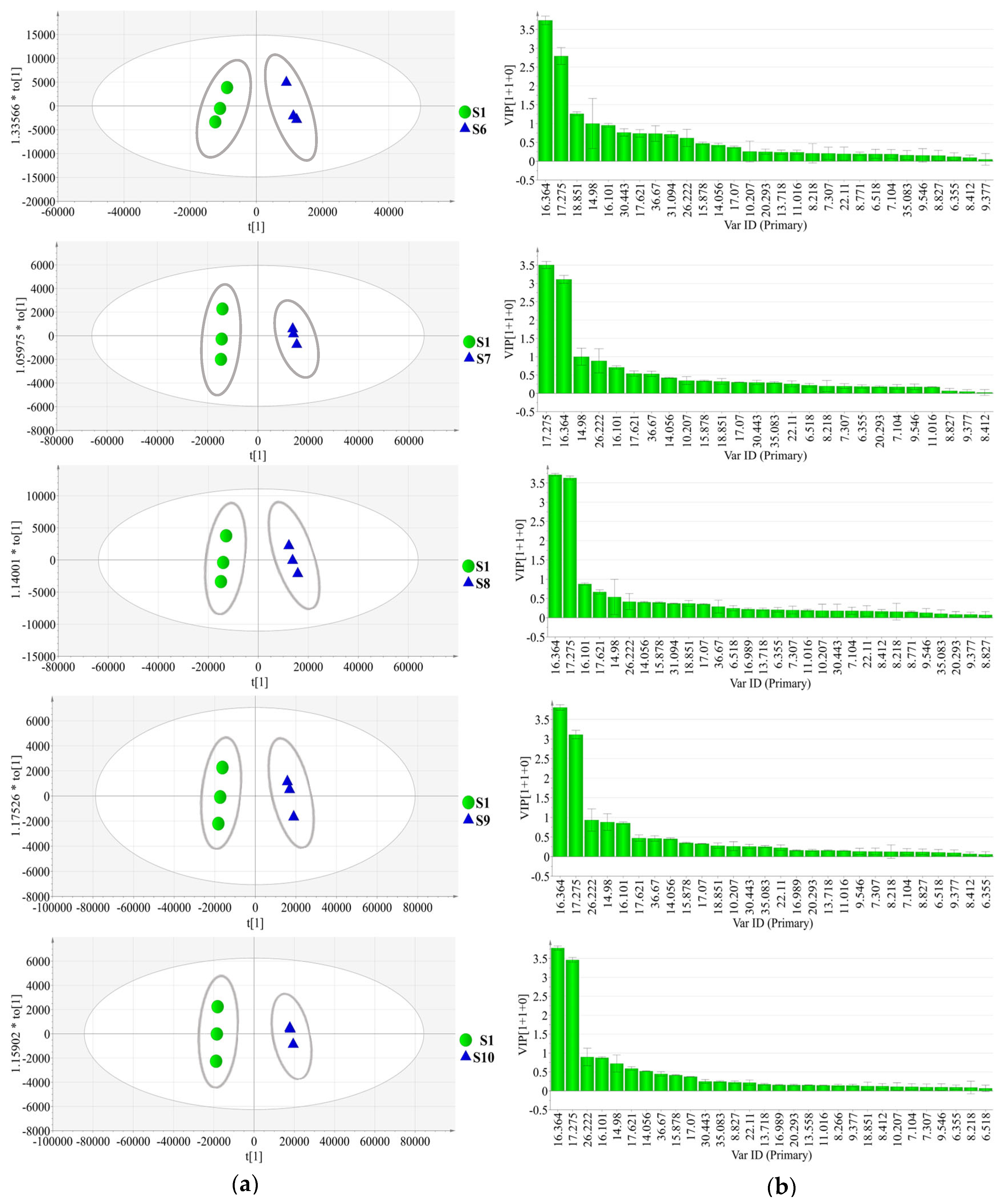
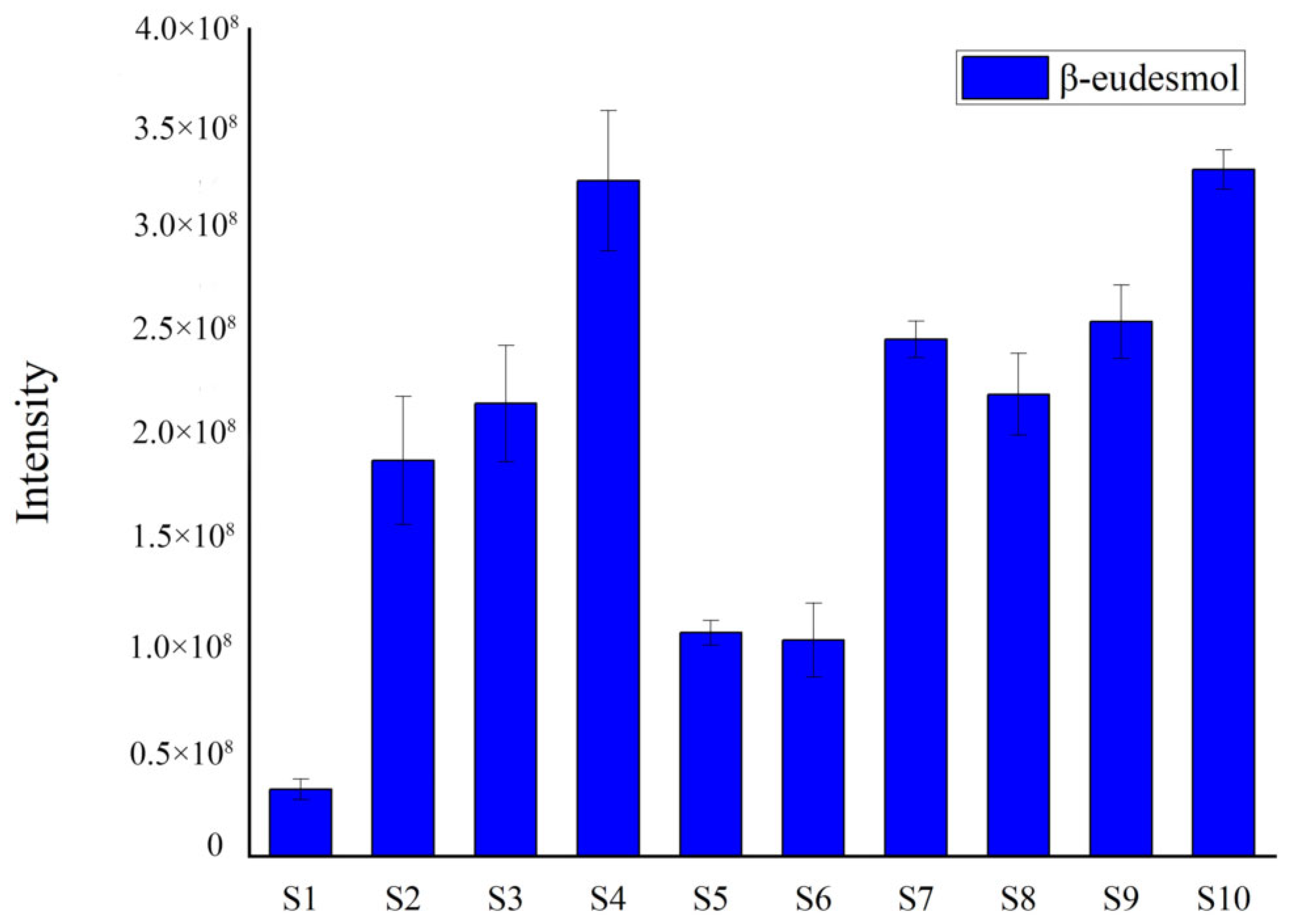
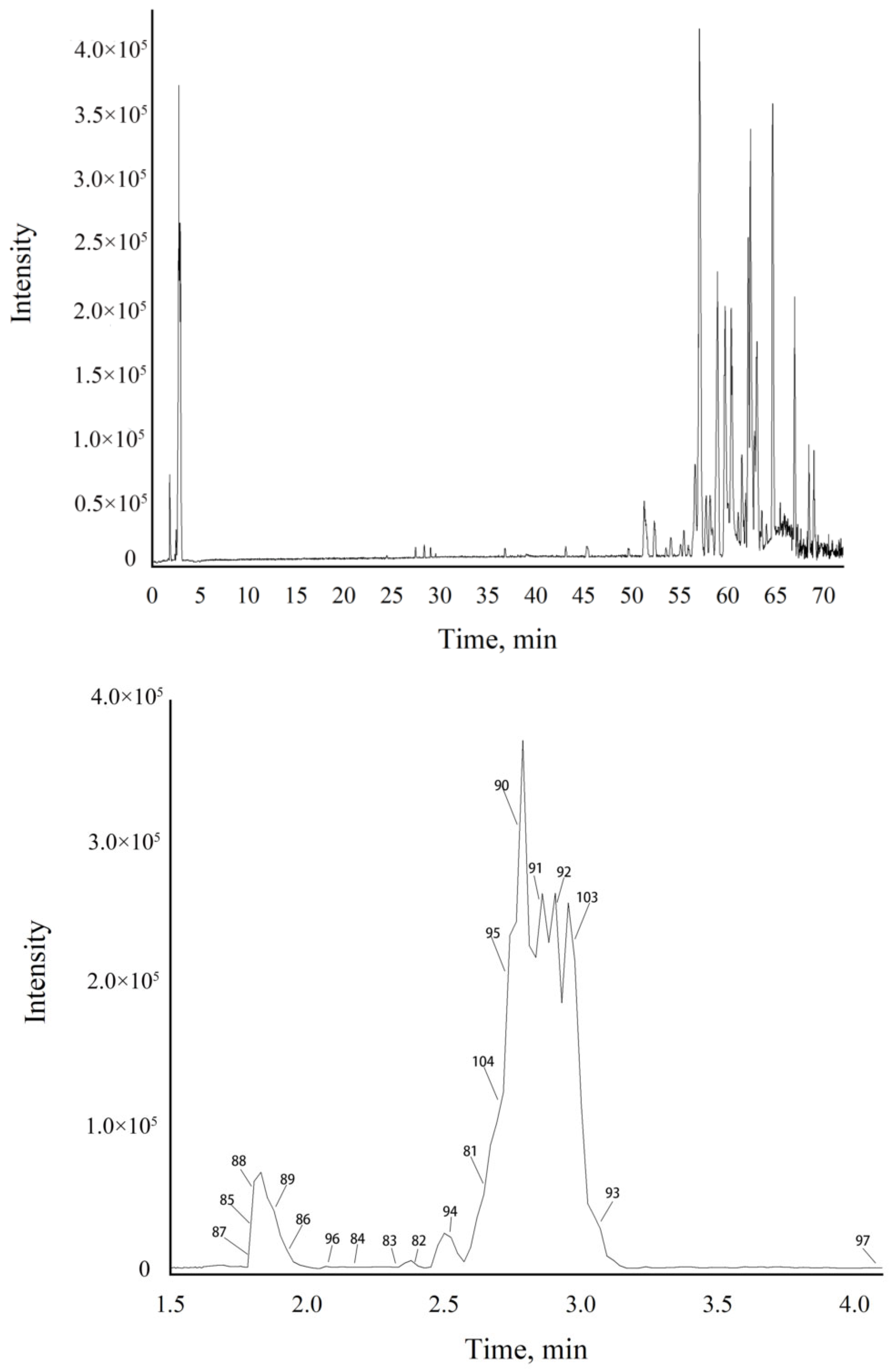
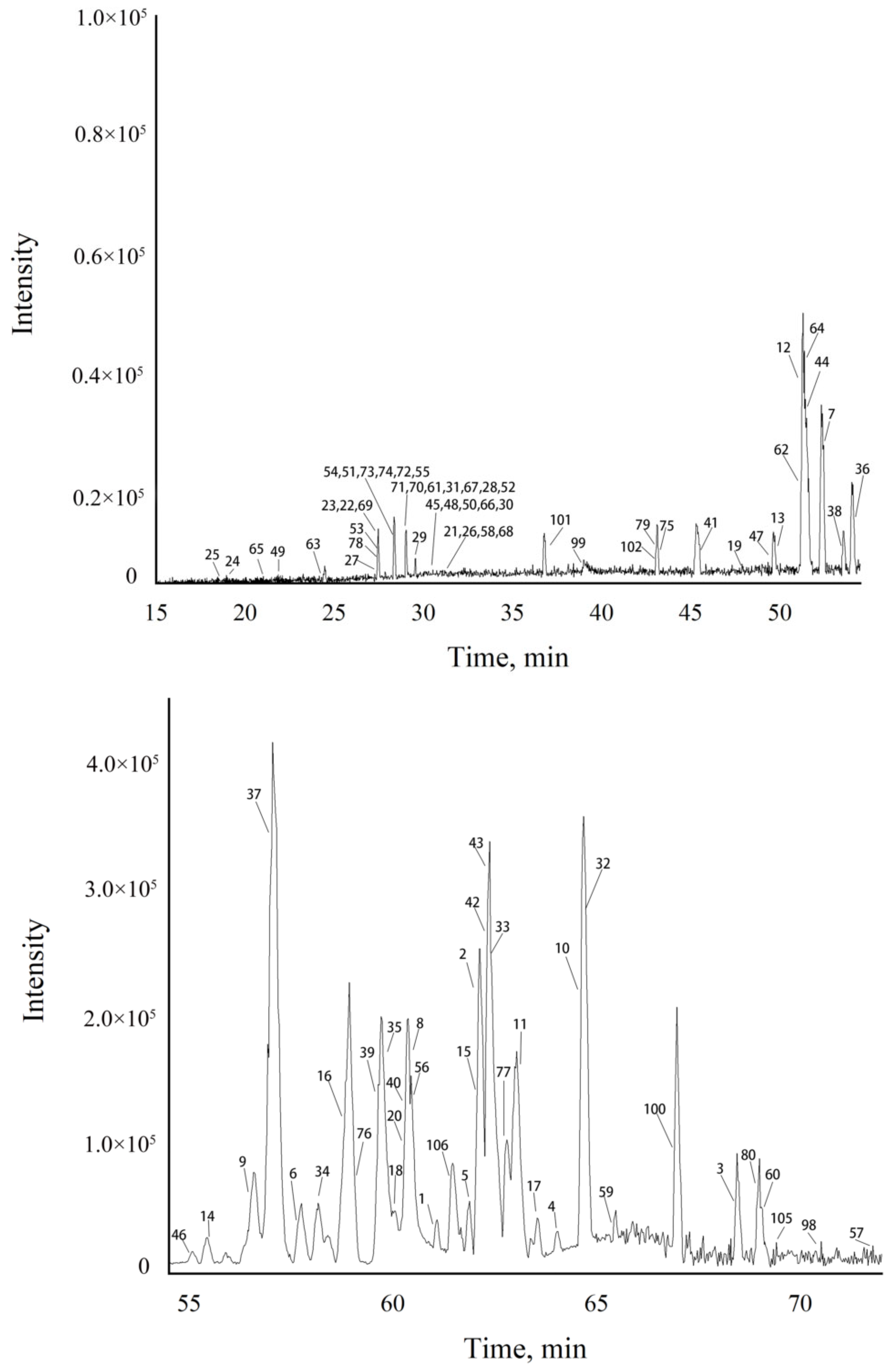
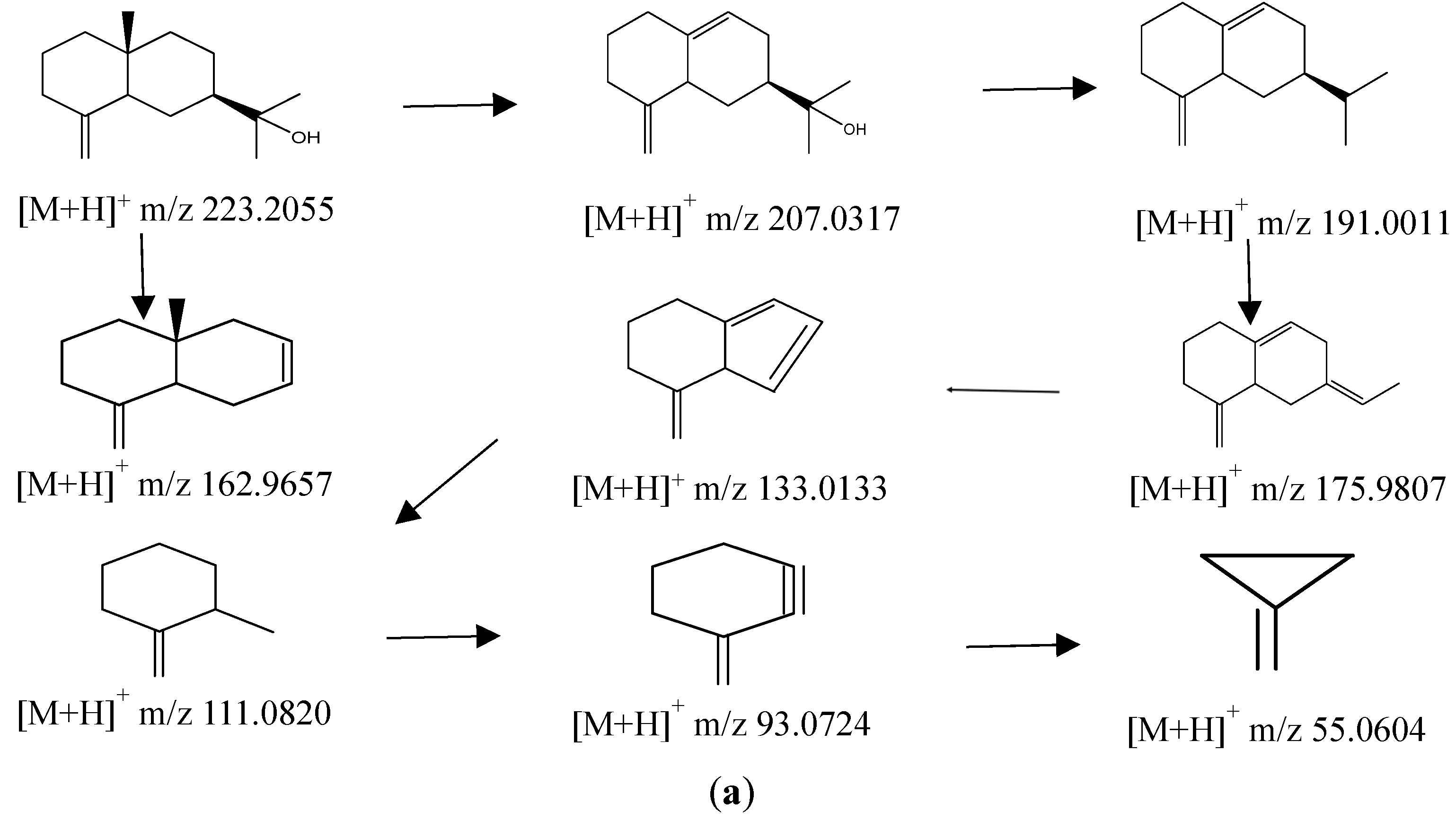


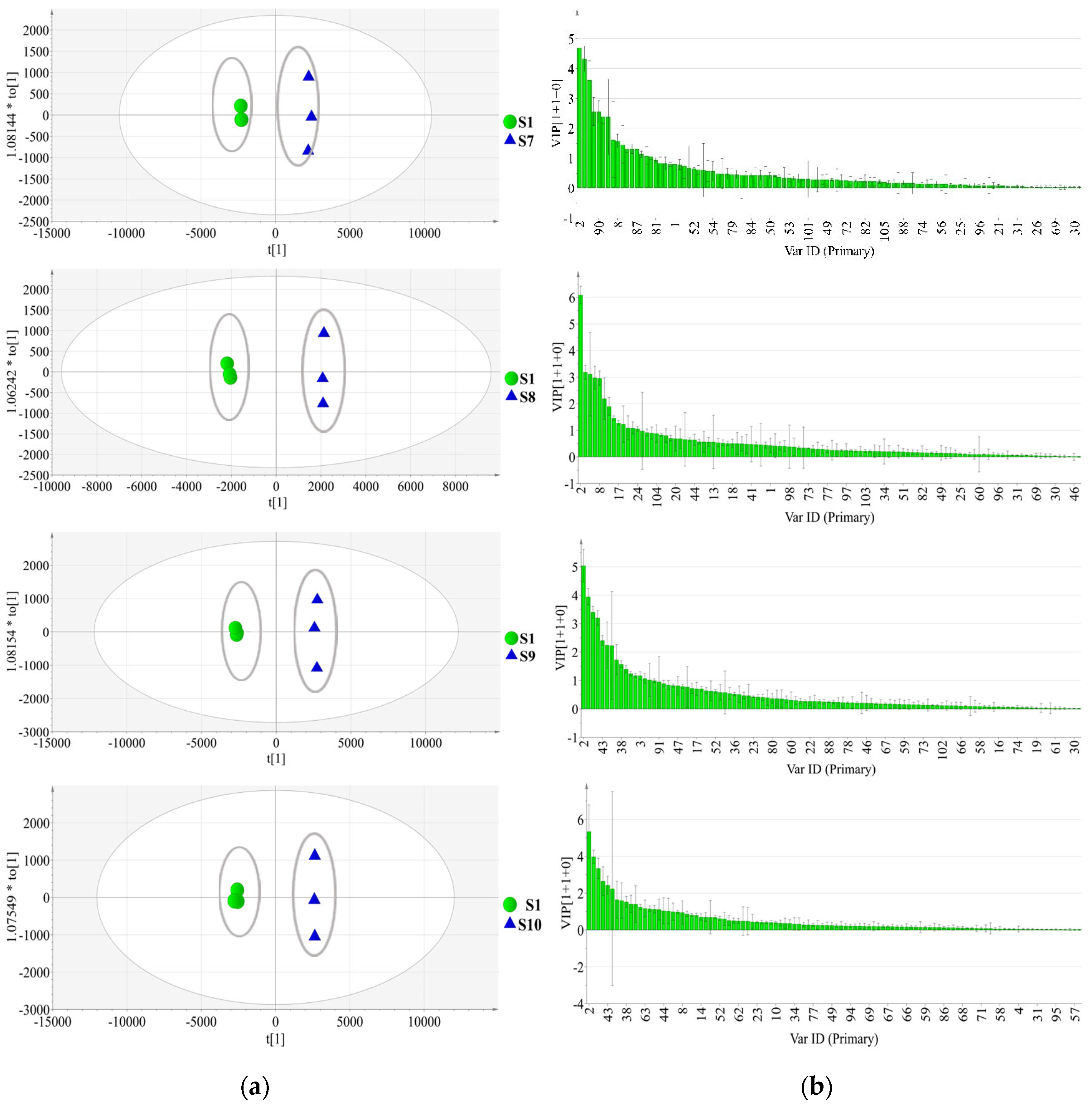
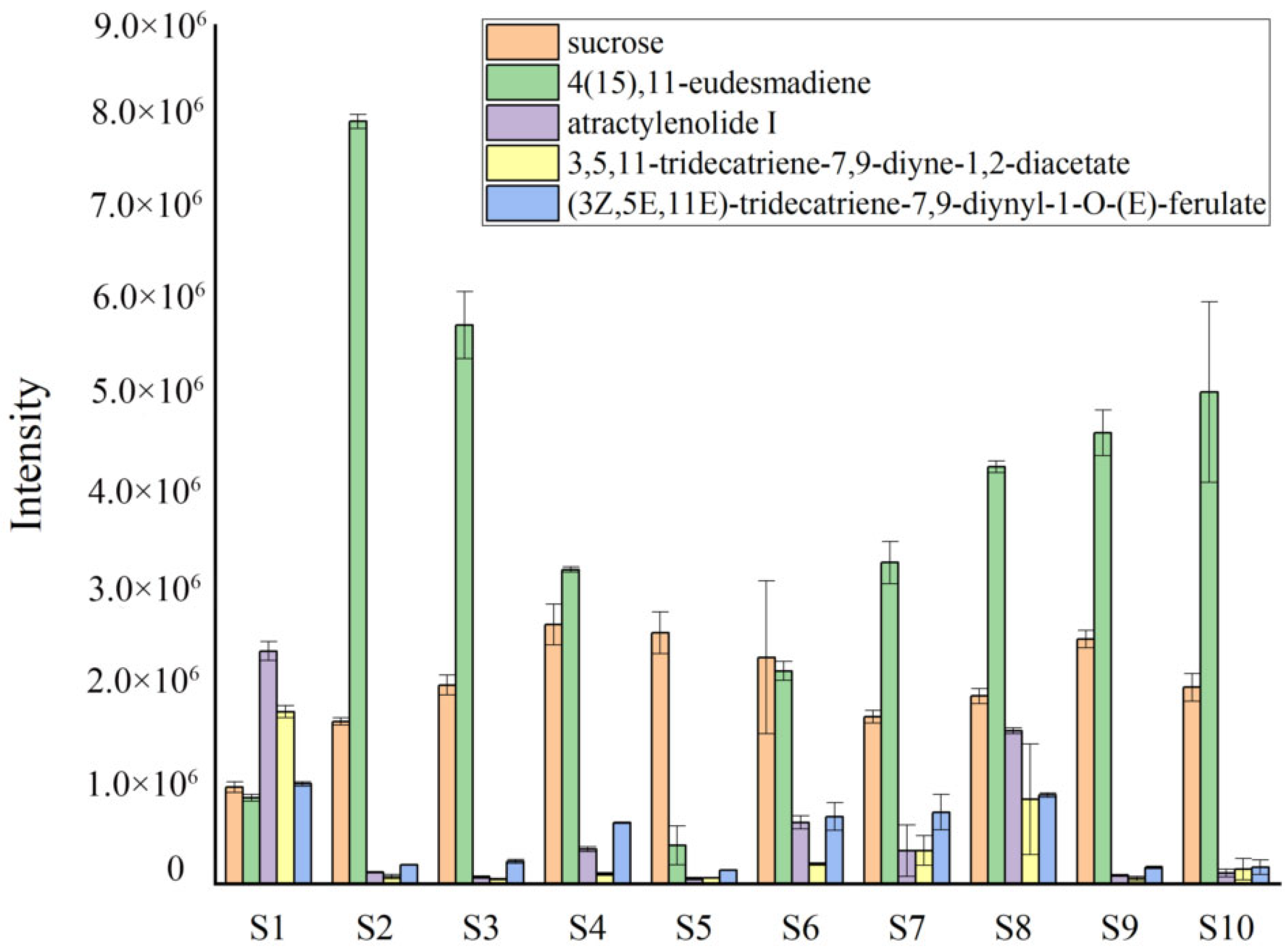
| No. | RT | Compound Name | Formula | CAS | Types |
|---|---|---|---|---|---|
| 1 | 6.36 | β-patchoulene | C15H24 | 514-51-2 | Sesquiterpenes |
| 2 | 6.52 | berkheyaradulene | C15H24 | 65372-78-3 | Sesquiterpenes |
| 3 | 7.10 | γ-gurjunene | C15H24 | 22567-17-5 | Sesquiterpenes |
| 4 | 7.31 | caryophyllene | C15H24 | 87-44-5 | Sesquiterpenes |
| 5 | 8.22 | humulene | C15H24 | 6753-98-6 | Sesquiterpenes |
| 6 | 8.27 | α-bulnesene | C15H24 | 3772-93-8 | Sesquiterpenes |
| 7 | 8.41 | (+)-α-longipinene | C15H24 | 5989-08-2 | Sesquiterpenes |
| 8 | 8.54 | trans-β-terpineol | C10H18O | 7299-41-4 | Monoterpenes |
| 9 | 8.77 | zingiberene | C15H24 | 495-60-3 | Sesquiterpenes |
| 10 | 8.83 | α-selinene | C15H24 | 473-13-2 | Sesquiterpenes |
| 11 | 9.38 | (E)-β-famesene | C15H24 | 18794-84-8 | Sesquiterpenes |
| 12 | 9.55 | aromandendrene | C15H24 | 489-39-4 | Sesquiterpenes |
| 13 | 10.21 | γ-elemene | C15H24 | 29873-99-2 | Sesquiterpenes |
| 14 | 11.02 | dehydro-aromadendrene | C15H22 | 1000156-12-5 | Sesquiterpenes |
| 15 | 13.56 | (−)-β-bourbonene | C15H24 | 5208-59-3 | Sesquiterpenes |
| 16 | 13.72 | 1,2,3,4,6,8α-hexahydro-1-isopropyl-4,7-dimethyl-naphthalene | C15H24 | 16728-99-7 | Sesquiterpenes |
| 17 | 14.06 | elemol | C15H26O | 639-99-6 | Sesquiterpenes |
| 18 | 14.98 | atractylone | C15H20O | 98309-94-5 | Sesquiterpenes |
| 19 | 15.88 | γ-eudesmol | C15H26O | 1209-71-8 | Sesquiterpenes |
| 20 | 16.10 | agarospirol | C15H26O | 1460-73-7 | Sesquiterpenes |
| 21 | 16.36 | hinesol | C15H26O | 23811-08-7 | Sesquiterpenes |
| 22 | 16.99 | α-bisabolol | C15H26O | 515-69-5 | Sesquiterpenes |
| 23 | 17.07 | α-eudesmol | C15H26O | 473-16-5 | Sesquiterpenes |
| 24 | 17.28 | β-eudesmol | C15H26O | 473-15-4 | Sesquiterpenes |
| 25 | 17.62 | hedycaryol | C15H26O | 21657-90-9 | Sesquiterpenes |
| 26 | 18.85 | selina-4(15),7(11)-dien-8-one | C15H22O | 54707-47-0 | Sesquiterpenes |
| 27 | 20.29 | spathulenol | C15H24O | 6750-60-3 | Sesquiterpenes |
| 28 | 22.11 | 7-ethynyl-1,4a-dimethyl-4a,5,6,7,8,8a-hexahydro-2(1H)-naphthalenone | C14H18O | 55220-87-6 | Others |
| 29 | 26.22 | atractylodin | C13H10O | 55290-63-6 | Polyethylenes |
| 30 | 30.44 | 3β-acetoxy-atractylone | C17H22O3 | 61206-10-8 | Sesquiterpene derivatives |
| 31 | 31.09 | prenortestosterone | C18H26O2 | 1089-78-7 | Sesquiterpene derivatives |
| 32 | 35.08 | 5-O-methyl-d-gluconic acid dimethylamide | C9H19NO6 | 13096-67-8 | Others |
| 33 | 36.67 | atractylenolide I | C15H18O2 | 73069-13-3 | Sesquiterpenes |
| Samples | Model Verification Results | Permutation Results | Number of Characteristic Peaks with VIP > 1 | |||
|---|---|---|---|---|---|---|
| R2X (cum) | R2Y (cum) | Q2 (cum) | R2 | Q2 | ||
| S1, S2 | 0.999 | 0.983 | 0.952 | 0.236 | −1.3 | 3 |
| S1, S3 | 0.999 | 0.989 | 0.968 | 0.12 | −1.34 | 3 |
| S1, S4 | 0.998 | 0.991 | 0.974 | 0.145 | −1.2 | 2 |
| S1, S5 | 0.997 | 0.996 | 0.992 | 0.119 | −1.44 | 3 |
| S1, S6 | 0.997 | 0.984 | 0.952 | 0.281 | −1.24 | 4 |
| S1, S7 | 0.999 | 0.999 | 0.997 | 0.118 | −1.33 | 2 |
| S1, S8 | 0.998 | 0.993 | 0.98 | 0.138 | −1.26 | 2 |
| S1, S9 | 0.999 | 0.996 | 0.99 | 0.122 | −1.26 | 2 |
| S1, S10 | 0.999 | 0.999 | 0.998 | 0.146 | −1.22 | 2 |
| No. | Formula | Compound | RT | Adduct | MS | Error (ppm) | MS/MS | Ref. |
|---|---|---|---|---|---|---|---|---|
| 1 | C15H22 | 4(15),11-eudesmadiene-2H | 61.79 | +H | 203.1789 | −2.66 | 158.0630, 121.1010, 105.0720, 81.0680 | [17] |
| 2 | C15H24 | 4(15),11-eudesmadiene | 63.03 | +H | 205.1952 | 0.70 | 149.1328, 135.1178, 121.1027, 107.0874, 95.0881, 81.0737, 67.0590, 55.0605 | [17] |
| 3 * | C15H20O | atractylone | 67.59 | +H | 217.1585 | −0.87 | 199.1491, 169.0938, 159.1141, 141.0691, 128.0635, 119.0844, 91.0585, 77.0407 | [18] |
| 4 * | C15H26O | β-eudesmol | 64.23 | +H | 223.2055 | −0.72 | 207.0317, 191.0011, 175.9807, 162.9657, 133.0133, 111.0820, 93.0724, 55.0604 | [19] |
| 5 * | C15H26O | hinesol | 62.87 | +H | 223.2052 | −1.97 | 207.0337, 191.0012, 162.9669, 107.0872, 73.0518, 69.0365 | [20] |
| 6 * | C15H18O2 | atractylenolide I | 58.38 | +H | 231.1378 | −0.61 | 213.1265, 185.1302, 155.0855, 141.0701, 128.0622, 115.0554, 105.0718, 91.0568, 79.0578 | [18] |
| 7 * | C15H20O2 | atractylenolides II | 53.54 | +H | 233.1534 | −0.86 | 215.1424, 187.1472, 145.1006, 131.0860, 115.0550, 105.0714, 91.0562, 79.0577 | [18,19] |
| 8 | C15H22O | selina-4(15),7(11)-dien-8-one | 61.47 | +H | 219.1737 | −2.92 | 123.0811, 111.0822, 105.0717, 95.0877, 77.0423, 55.0606 | [21] |
| 9 | C15H22O2 | (5R,10S)-eudesm-4(15),7-diene-11-ol-9-one | 57.01 | +H | 235.1696 | 1.45 | 179.1070, 57.0756 | [22] |
| 10 | C15H24O2 | eudesm-4(15),7-diene-9α,11-diol or isomer | 65.01 | +Na | 259.1667 | −0.58 | 175.0776, 161.0596, 137.0609 | [22] |
| 11 | C15H26O2 | eudesm-4(15)-ene-7α,11-diol or isomer | 63.79 | +H | 239.2027 | 8.95 | 207.0301 | [22] |
| 12 * | C15H28O2 | cryptomeridiol | 52.75 | +K | 279.1709 | −6.10 | 261.1513, 201.0942, 185.0629, 149.0231, 96.9992, 71.9549, 56.9718 | [23] |
| 13 * | C15H20O3 | atractylenolides III | 49.66 | +H | 249.1483 | −0.92 | 231.1370, 213.1265, 175.0749, 163.0752, 161.0593, 105.0737, 91.0575 | [19,24] |
| 14 | C15H20O3 | atractylenolide III isomer | 55.64 | +H | 249.1493 | 3.05 | 232.14615, 204.15298, 189.12842, 177.08931, 161.09698, 105.07215, 91.05746, 79.05825 | [24] |
| 15 | C15H24O3 | 2-oxo-15-hydroxy-hinesol | 62.95 | +Na | 275.1637 | 6.90 | 215.1436 | [25] |
| 16 | C15H26O3 | 4α,7α-epoxyguaiane-10α,11-diol or isomer | 59.25 | +H | 255.1950 | −1.84 | 233.1012 | [22] |
| 17 | C15H28O3 | atractylol A | 64.20 | +K | 295.1665 | −1.69 | 226.9452, 207.0241, 205.1076, 177.0779, 161.0596, 158.9697, 133.0879, 121.0521 | [25] |
| 18 | C15H26O4 | 10β,11β-epoxyguaiane-1α,4α,7α-triol | 60.05 | +K | 309.1464 | 0.26 | 165.0685, 141.0686, 128.0595, 115.0574 | [22] |
| 19 | C18H24O5 | 8-β-methoxy-atractylenolide IV | 47.37 | +H | 321.1700 | 1.09 | 289.1408, 229.1240, 187.0723, 161.0605, 159.1154, 84.9646 | [26] |
| 20 | C20H30O7 | (5R,7R)-14-hydroxy-3,4-dehydrohinesolone-14-O-β-d xylopyranoside | 60.35 | +H | 383.2060 | −1.07 | 351.2198, 323.2198, 165.0596 | [27] |
| 21 | C21H36O7 | atractyloside C | 31.23 | +Na | 423.2355 | 0.40 | 203.0535 | [28] |
| 22 | C21H38O8 | ophiopogonoside A | 27.59 | +Na | 441.2458 | −0.20 | 423.24942, 288.92529, 203.05148 | [29] |
| 23 | C21H36O9 | 3,4,11,14-tetrahydroxyl-guaia-9-en-11-O-β-D-glucopyranoside | 27.49 | +Na | 455.2254 | 0.55 | 275.1626, 203.0502 | [30,31] |
| 24 | C21H36O10 | atractyloside A | 18.70 | +Na | 471.2199 | −0.36 | 291.1540, 203.0513 | [28] |
| 25 | C21H38O10 | atractyloside B | 17.90 | +Na | 473.2347 | −2.16 | 293.1722, 203.0530 | [28] |
| 26 | C26H40O11 | (7R)-3,4-dehydrohinesolone-11-O-β-d-apiofuranosyl-(1→6)-β-d-glucopyranoside | 31.42 | +Na | 551.2478 | 2.76 | 335.0966, 239.1451 | [28] |
| 27 | C27H46O12 | atractyloside D | 26.99 | +Na | 585.2880 | −0.26 | 405.2239, 203.0524 | [28] |
| 28 | C27H46O13 | (2R,3R,5R,7R,10S)-atractyloside G-2-O-β-d-glucopyranoside | 29.70 | +Na | 601.2837 | 1.06 | 421.2214, 365.1131, 219.0903, 203.0547 | [32] |
| 29 | C29H46O14 | (5R,7R,10S)-6″-O-acetylatractyloside I or isomer | 29.85 | +H | 619.2936 | −3.89 | 575.1916, 439.2272 | [33] |
| 30 | C32H54O16 | atractyloside E | 30.97 | +Na | 717.3315 | 1.52 | 537.2836, 509.0910 | [28] |
| 31 | C32H54O17 | atractyloside H | 29.46 | +Na | 733.3226 | −3.71 | 553.2485, 421.2140, 335.0881 | [28] |
| 32 | C37H62O20 | atractyloside F | 65.27 | +Na | 849.3683 | −5.12 | 471.1929, 455.1746, 387.1305, 267.0492, 213.0356 | [28] |
| 33 * | C13H10O | atractylodin | 63.55 | +H | 183.0801 | −1.86 | 165.0698, 153.0683, 139.0518, 127.0500, 115.0558, 91.0597, 77.0375, 51.0293 | [34] |
| 34 | C13H10O2 | atractylodinol | 58.95 | +H | 199.0760 | 3.21 | 165.0700, 154.0650, 127.0540 | [34] |
| 35 | C15H16O2 | (2Z,4E,10E)-dodeca-2,4,10-trien-6,8-diynyl acetate or isomer | 61.18 | +Na | 251.1045 | 0.80 | 153.0688 | [35] |
| 36 | C15H12O3 | acetylatractylodinol | 54.07 | +Na | 263.0678 | −0.27 | 189.0186, 170.9241, 142.0810, 84.9651 | [34] |
| 37 | C17H18O4 | 3,5,11-tridecatriene-7,9-diyne-1,2-diacetate | 58.17 | +Na | 309.1103 | 1.84 | 249.0886, 227.1077, 167.0859, 165.0703, 152.0623, 141.0707, 129.0713, 128.0635, 115.0555, 91.0567 | [36] |
| 38 | C17H16O5 | 1-(2-furyl)-(7E)-nonene-3,5-diyne-1,2-diacetate | 54.03 | +Na | 323.0891 | 0.28 | 263.0691, 241.0867, 213.0908, 199.0760, 181.0651, 171.0803, 152.0622, 141.0704, 128.0635, 127.0551, 115.0557, 93.0371 | [36] |
| 39 | C18H20O4 | (4E,6E,12E)-Tetradecatriene-8,10-diyne-1,3-diyl diacetate | 59.80 | +Na | 323.1253 | −0.25 | 178.0777, 165.0700, 152.0628, 141.0707, 115.0556 | [37] |
| 40 | C17H18O5 | atractylodin+2 HAc | 60.59 | +Na | 325.1040 | −2.00 | 265.1201, 183.1150, 165.0700, 141.0691, 127.0530, 115.0566, 103.0599, 91.0562 | [38] |
| 41 | C18H20O5 | 12,14-diacetate-2E,8E,10E-trien-4,6-diyne-1-ol | 46.78 | +Na | 339.1206 | 0.88 | 197.0965, 178.0785, 153.0703, 141.0707, 128.0633, 115.0547, 91.0562, 77.0426 | [35] |
| 42 | C20H22O4 | 3,5,11-tridecatriene-7,9-diyne-1,2-diacetate+-CH=CH-CH= | 63.11 | +Na | 349.1419 | 2.61 | 303.11581, 289.12268, 225.15495, 209.0451, 165.06985, 127.05454 | [38] |
| 43 | C23H22O4 | (3Z,5E,11E)-tridecatriene-7,9-diynyl-1-O-(E)-ferulate | 63.14 | +Na | 385.1409 | −0.34 | 265.1475, 169.0960, 153.0646 | [37] |
| 44 | C16H24O7 | (8S)-decene-4,6-diyne-1,8-diol-8-O-β-d-glucopyranoside | 53.19 | +K | 367.1145 | −2.34 | 307.0940, 181.0577, 165.0711, 153.0696, 139.0541, 127.0542, 115.0534, 77.0478 | [38] |
| 45 | C19H24O8 | (8S,9R)-2E,10Z,12-tridecadiene-4,6-diyne-1,8,9-triol-8-O-β-d-glucopyranoside or isomer | 30.28 | +Na | 403.1360 | -0.84 | 203.0548, 201.0393 | [38] |
| 46 | C22H22O6 | Atractylodinol+-C≡C-CH2-+Rha | 54.92 | +H | 383.1498 | 2.30 | 323.1218, 237.1132, 222.9705, 199.0979, 165.0704, 153.0717, 141.0691, 127.0530 | [38] |
| 47 | C17H22O8S | atracthioenyneside B | 49.06 | +H | 387.1117 | 2.27 | 341.1051, 183.0801, 181.0631, 153.0692, 141.0234, 127.0538, 115.0552 | [38] |
| 48 | C20H26O8 | (8E,10E)-tetradecatriene-4,6-diyne-3,12,14-triol-3-O-β-d-glucopyranoside or isomer | 30.33 | +K | 433.1252 | −1.62 | 365.1022, 201.0054 | [38] |
| 49 | C19H22O9 | (8R,9R)-8,9-dihydroxylatractylodinol-8-O-β-d-glucopyranoside or isomer | 22.69 | +H | 395.1322 | −3.69 | 233.0777, 185.0438 | [38] |
| 50 | C23H34O11 | (2E,10S)-tridecane-2-ene-4,6-diyne-1,10,13-triol-1,13-di-O-β-d-xylopyranoside | 30.46 | +H | 487.2155 | −3.88 | 335.0947, 275.0670 | [38] |
| 51 | C22H32O12 | (2E,8R)-decene-4,6-diyne-1,8-diol-O-di-β-d-glucopyranoside | 28.32 | +Na | 511.1790 | 0.80 | 479.2397, 331.1006, 203.0734 | [38] |
| 52 | C24H32O12 | (8S,9R)-2E,10Z,12-tridecadiene-4,6-diyne-1,8,9-triol-8-O-β-d-apiofuranosyl-(1→6)-β-d-glucopyranoside or isomer | 29.78 | +Na | 535.1783 | −0.62 | 335.0952, 273.1044, 203.0588 | [38] |
| 53 | C25H34O12 | (2E,8E,10E,12R)-tetradeca-2,8,10-triene-4,6-diyne-1,2,14-triol-1-O-β-d-apiofuranosyl-(1→6)-β-d-glucopyranoside | 27.41 | +Na | 549.1940 | −0.46 | 387.1441, 189.0537 | [38] |
| 54 | C25H34O13 | (2E,8E,10E,12R)-tridecatriene-4,6-diyne-1,12,13-triol-1,12-di-O-β-d-glucopyranoside or isomer | 28.25 | +Na | 565.1893 | 0.25 | 519.1195, 323.0466, 203.0549 | [38] |
| No. | MW | Name | RT | Adduct | MS | Error (ppm) | MS/MS |
|---|---|---|---|---|---|---|---|
| 55 | C16H28O7 | (1R,2R,4S)-2-hydroxy-1,8-cineole-β-d-glucopyranoside or isomer | 28.88 | +Na | 355.1726 | −0.28 | 203.0524 |
| 56 * | C20H32O2 | ent-kauran-16β-ol-19-al | 61.69 | +Na | 327.2298 | 1.07 | 309.1835, 288.6881, 277.1044, 267.1307, 152.0590, 127.0091, 77.0088 |
| 57 | C30H48O3 | 3-epiursolic acid | 71.95 | +Na | 479.3487 | −1.81 | 343.02658, 147.06119, 73.05546 |
| 58 | C41H66O13 | scabioside C | 31.50 | +Na | 789.4460 | 8.16 | 788.4479 |
| 59 * | C32H52O2 | traxerol acetate | 65.38 | +Na | 491.3873 | 2.75 | 445.2804, 431.3595, 269.1376, 236.1359, 193.1286, 161.1308 |
| 60 * | C29H50O | β-sitosterol | 69.04 | +Na | 437.3765 | 2.56 | 369.1972, 301.2097, 121.0989, 90.9812 |
| 61 | C35H58O6 | stigmasterol glucoside | 29.45 | +Na | 597.4150 | 4.15 | 475.34491, 457.3175, 434.24863, 369.09949 |
| 62 | C15H16O3 | osthol | 52.30 | +Na | 267.0998 | 2.36 | 165.0654, 115.0544 |
| 63 | C16H18O9 | isoscopoletin-6-O-β-d-glucopyranoside | 24.47 | +H | 355.1031 | 2.08 | 163.0390, 145.0299, 135.0490, 117.0357, 89.0390 |
| 64 | C17H24O9 | syringin | 53.08 | +H | 373.1508 | 3.99 | 357.0629, 168.9929, 252.9665, 220.9322, 178.9612, 90.9769, 73.0507 |
| 65 | C21H26O12 | umbelliferone-7-O-α-L-rhamnopyranosyl-(1→6)-β-d-glucopyranoside | 21.76 | +Na | 493.1319 | 0.51 | 331.1022 |
| 66 | C22H28O13 | scopoletin-7-O-α-L-rhamnopyranosyl-(1→6)-β-d-glucopyranoside | 30.95 | +K | 539.1165 | 0.65 | 521.1151, 377.0853, 359.0731, 331.0757, 163.0388,185.0177, 197.0404, 163.0388 |
| 67 | C10H8O4 | scopoletin | 29.57 | +H | 193.0499 | 1.86 | 178.02585, 161.01437, 150.03203, 133.03062, 122.03758, 105.03378, 94.04397, 77.03789 |
| 68 | C11H10O4 | 6,7-dimethoxychromen-2-one | 31.72 | +H | 207.0654 | 1.01 | 191.03391, 179.07031, 163.03935, 151.07645, 145.02959, 135.04448, 118.04246, 107.05118, 91.05722, 89.04136, 77.04197 |
| 69 | C25H32O11 | 3′,9,9′-trihydroxy-3-methoxyI-7,8-dihydrobenzofuran-1′-propanolneolignan-4-O-β-d-glucopyranoside | 27.78 | +Na | 531.1831 | −1.09 | 513.1563, 501.1827, 339.1278, 305.0925, 185.0434 |
| 70 | C26H34O11 | (+)-Isolariciresinol-9′-O-β-d-glucopyranoside | 29.43 | +Na | 545.1995 | 0.31 | 383.1396 |
| 71 | C26H36O11 | secoisolariciresinol-4-O-β-d-glucopyranoside or isomer | 29.08 | +Na | 547.2143 | −1.24 | 385.1695185.0332, 159.0377 |
| 72 | C26H36O12 | (7R,8S)-5-methoxyldihydrodehydrodiconiferylalconol-4-O-β-d-glucopyranoside | 28.76 | +Na | 563.2093 | −1.07 | 353.1351, 204.0735 |
| 73 | C27H36O13 | longifloroside B | 28.40 | +Na | 591.2042 | −1.03 | 429.1518, 351.1049, 232.0716 |
| 74 | C27H38O13 | longifloroside B+2H | 28.74 | +Na | 593.2188 | −2.78 | 431.1657, 234.0896 |
| 75 | C17H22O10 | (7E)-sinapate-4-O-β-d-glucopyranoside | 44.90 | +K | 425.0841 | −0.85 | 193.0448, 149.0239 |
| 76 | C12H14O4 | diethyl phthalate | 59.72 | +H | 223.0966 | 0.49 | 207.0329, 191.0018, 149.0247, 73.0510 |
| 77 | C18H26O2 | 2-[(2′E)-3′,7′-dimethyl-2′, 6′-octadienyl]-4-methoxy-6-methyl phenol | 63.60 | +H | 275.2003 | −0.94 | 205.1229, 191.1086, 177.0946, 151.0776, 123.0760 |
| 78 | C19H28O10 | phenylmethanol 7-O-α-l-rhamnopyranosyl-(1→6)-β-d-glucopyranoside | 27.38 | +H | 417.1735 | −4.84 | 347.0970, 271.1149 |
| 79 | C17H22O5 | trans-2-hydroxyisoxypropyl-3-hydroxy-7-isopentene-2,3-dihydrobenzofuran-5-carboxylic acid | 44.75 | +Na | 329.1359 | −0.30 | 289.1481, 271.1285, 239.0882, 205.0832, 179.0333, 163.0374, 149.0283, 119.0541, 69.0739 |
| 80 | C24H38O4 | bis(2-ethylhexyl) phthalate | 69.00 | +H | 391.2841 | −0.49 | 279.1599, 149.0244, 121.03027, 71.09079 |
| 81 | C5H11NO2 | valine | 2.54 | +H | 118.0866 | 2.88 | 58.0709 |
| 82 | C5H7NO3 | 5-oxo-l-proline | 2.40 | +H | 130.0501 | 1.77 | 84.0478, 56.0558 |
| 83 | C4H8N2O3 | asparagine | 2.37 | +H | 133.0611 | 2.48 | 116.04055, 87.05751, 74.02784, 53.01179 |
| 84 | C5H11N3O2 | 4-guanidino-butanoate | 2.24 | +H | 146.0924 | 0.00 | 128.08316, 104.0715, 86.06216, 69.03831, 60.06041 |
| 85 | C6H9N3O2 | histidine | 1.84 | +H | 156.0767 | −0.32 | 110.07291, 93.04785, 83.06383, 66.04191, 56.05435 |
| 86 | C7H15NO3 | carnitine | 1.97 | +H | 162.1123 | −1.05 | 103.04109, 85.03056, 58.07046 |
| 87 | C6H14N4O2 | arginine | 1.83 | +H | 175.1191 | 0.57 | 70.0694, 60.0610 |
| 88 | C7H16N4O2 | targinine | 1.89 | +H | 189.1345 | −0.53 | 144.112, 116.07196, 70.06947, 57.05048 |
| 89 | C8H18N4O2 | symmetric dimethylarginine | 1.93 | +H | 203.1502 | −0.25 | 172.10738, 158.12762, 133.10193, 116.07109, 88.08673, 70.06877 |
| 90 | C12H22O11 | sucrose | 2.77 | +Na | 365.1055 | 0.19 | 347.0935, 275.0727, 203.0522, 185.0416 |
| 91 | C18H32O16 | melezitose | 2.89 | +Na | 527.1581 | −0.30 | 365.1039, 347.0937, 275.0712, 203.0515, 185.0409 |
| 92 | C24H42O21 | stachyose | 2.96 | +Na | 689.2097 | −1.97 | 527.1546, 509.1450, 365.1038, 347.0933, 203.0519, 185.0417 |
| 93 | C10H13N5O4 | adenosine | 3.18 | +H | 268.1044 | 1.38 | 136.0619, 119.034 |
| 94 | C5H5N5 | adenine | 2.51 | +H | 136.0623 | 3.90 | 119.03603, 92.02648, 77.01751, 65.01727, 55.03499 |
| 95 | C5H7N3O | 5-methylcytosine | 2.72 | +H | 126.0667 | 4.05 | 109.0421, 83.0635, 54.0397 |
| 96 | C4H5N3O | cytosine | 2.23 | +H | 112.0508 | 2.32 | 95.02696, 67.03505, 52.02482 |
| 97 | C6H6N2O | nicotinamide | 4.07 | +H | 123.0558 | 4.14 | 106.03112, 80.05253, 53.04439 |
| 98 | C22H43NO | erucamide | 70.06 | +H | 338.3414 | −1.00 | 321.3154, 303.30508, 163.15129, 149.13307, 135.1179, 97.10375, 83.08909 |
| 99 | C14H31NO | N,N-dimethyldodecylamine N-oxide | 39.43 | +H | 230.2481 | 1.13 | 212.2370, 58.0706 |
| 100 | C18H24O2 | galaxolidone | 66.72 | +H | 273.1847 | −0.77 | 255.1843 |
| 101 | C16H35NO2 | lauryldiethanolamine | 36.77 | +H | 274.2744 | 1.24 | 256.26328, 230.24826, 106.08877, 88.07969, 70.07063, 57.07623 |
| 102 | C18H39NO2 | 2,2′-(tetradecylimino) diethanol | 43.03 | +H | 302.3053 | −0.20 | 284.29459, 258.27921, 106.08905, 88.07846 |
| 103 | C19H20O5 | 6a,7,8-trihydroxy-3-methyl-3,4,5,6,7,12a-hexahydro-2H-benzo[a]anthracene-1,12-dione | 2.98 | +Na | 351.1192 | −3.13 | 333.0990 |
| 104 | C19H20O6 | lasepitin | 2.67 | Na | 367.1137 | −5.6 | 269.9946, 205.0700, 88.0824 |
| 105 | C27H50O6 | tricaprylin | 69.85 | +Na | 493.3487 | −2.55 | 349.2350, 327.2496, 127.1130 |
| 106 | C32H54O15 | 1,3,4,6-tetrakis-O-(3-methylbutanoyl)-β-d-fructofuranosyl-α-d-glucopyranoside | 62.14 | +Na | 701.3349 | −1.6 | 539.2818 |
| Samples | Model Verification Results | Permutation Results | Number of Characteristic Peaks with VIP > 1 | |||
|---|---|---|---|---|---|---|
| R2X (cum) | R2Y (cum) | Q2 (cum) | R2 | Q2 | ||
| S1, S2 | 0.978 | 1 | 1 | 0.719 | −0.518 | 12 |
| S1, S3 | 0.982 | 0.999 | 0.998 | 0.142 | −1.02 | 15 |
| S1, S4 | 0.955 | 1 | 0.998 | 0.856 | −0.395 | 13 |
| S1, S5 | 0.962 | 0.999 | 0.998 | 0.664 | −0.705 | 17 |
| S1, S6 | 0.953 | 0.999 | 0.996 | 0.356 | −0.816 | 13 |
| S1, S7 | 0.97 | 0.999 | 0.996 | 0.64 | −0.661 | 16 |
| S1, S8 | 0.934 | 1 | 0.996 | 0.777 | −0.272 | 13 |
| S1, S9 | 0.974 | 0.999 | 0.998 | 0.555 | −0.774 | 15 |
| S1, S10 | 0.87 | 0.999 | 0.987 | 0.359 | −0.35 | 17 |
| No. | Habitat | Longitude and Latitude (°) |
|---|---|---|
| S1 | Maoshan Region, Jiangsu | 119.315350, 31.781150 |
| S2 | Huoshan, Luan, Anhui | 116.33269, 31.39279 |
| S3 | Xixia, Henan | 111.47244, 33.3056 |
| S4 | Tongbai, Henan | 113.42892, 32.37913 |
| S5 | Guangshan, Xinyang, Henan | 114.91878, 32.00997 |
| S6 | Yingshan, Huanggang, Hubei | 115.68143, 30.73518 |
| S7 | Suizhou, Hubei | 113.3712, 31.71615 |
| S8 | Luotian, Huanggang, Hubei | 115.39927, 30.78399 |
| S9 | Yunxi, Shiyan, Hubei | 110.42588, 32.99306 |
| S10 | Yecun, Shangluo, Shanxi | 110.1353, 33.7643 |
Disclaimer/Publisher’s Note: The statements, opinions and data contained in all publications are solely those of the individual author(s) and contributor(s) and not of MDPI and/or the editor(s). MDPI and/or the editor(s) disclaim responsibility for any injury to people or property resulting from any ideas, methods, instructions or products referred to in the content. |
© 2023 by the authors. Licensee MDPI, Basel, Switzerland. This article is an open access article distributed under the terms and conditions of the Creative Commons Attribution (CC BY) license (https://creativecommons.org/licenses/by/4.0/).
Share and Cite
Qiu, H.; Shan, C.; Fei, C.; Xue, P.; Zhou, Y.; Yuan, J.; Liu, X. Geoherbalism Metabolomic Analysis of Atractylodes lancea (Thunb.) DC. by LC-Triple TOF-MS/MS and GC-MS. Molecules 2023, 28, 5974. https://doi.org/10.3390/molecules28165974
Qiu H, Shan C, Fei C, Xue P, Zhou Y, Yuan J, Liu X. Geoherbalism Metabolomic Analysis of Atractylodes lancea (Thunb.) DC. by LC-Triple TOF-MS/MS and GC-MS. Molecules. 2023; 28(16):5974. https://doi.org/10.3390/molecules28165974
Chicago/Turabian StyleQiu, Hailong, Chenxiao Shan, Chenghao Fei, Ping Xue, Yongyi Zhou, Jiahuan Yuan, and Xin Liu. 2023. "Geoherbalism Metabolomic Analysis of Atractylodes lancea (Thunb.) DC. by LC-Triple TOF-MS/MS and GC-MS" Molecules 28, no. 16: 5974. https://doi.org/10.3390/molecules28165974
APA StyleQiu, H., Shan, C., Fei, C., Xue, P., Zhou, Y., Yuan, J., & Liu, X. (2023). Geoherbalism Metabolomic Analysis of Atractylodes lancea (Thunb.) DC. by LC-Triple TOF-MS/MS and GC-MS. Molecules, 28(16), 5974. https://doi.org/10.3390/molecules28165974






